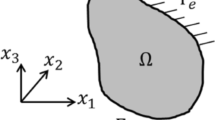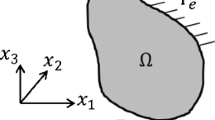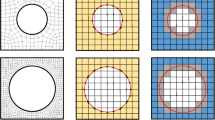Summary
This paper presents a formulation for the determination of design sensitivities for shape optimization in materially nonlinear problems. This approach is based on direct differentiation (DDA) of the relevant boundary element method (BEM) formulation of the problem. It combines the accuracy advantages of the BEM without the difficulty of dealing with strongly singular kernels. This approach provides a new avenue towards efficient shape optimization of small strain elastic-viscoplastic and elastic-plastic problems.
Similar content being viewed by others
References
Haug, E. J., Choi, K. K., Komkov, V.: Design sensitivity analysis of structural systems. New York: Academic Press 1986.
Tsay, J. J., Arora, J. S.: Design sensitivity analysis of nonlinear structures with history dependent effects. Technical Report No. ODL-88.4, Optimal Design Laboratory, College of Engineering, The University of Iowa, Iowa City, Iowa 52242 (1988).
Kane, J. H., Saigal, S.: Design sensitivity analysis of solids using BEM. ASCE J. Engrg. Mech.,114, 1703–1722 (1988).
Barone, M. R., Yang, R. J.: Boundary integral equations for recovery of design sensitivities in shape optimization. AIAA J.26, 589–594 (1988).
Mota Soares, C. A., Leal, R. P., Choi, K. K.: Boundary elements in shape optimal design of structural components. (Mota Soares, C. A., ed.), NATO ASI Series,F27, Berlin: Springer Verlag 1987.
Kwak, B. M., Choi, J. H.: Shape design sensitivity analysis using boundary integral equation for potential problems. In: Computer Aided Optimal Design: Structural and Mechanical Systems, (Mota Soares, C. A., ed.), NATO ASI Series,F27, Berlin: Springer Verlag 1987.
Rizzo, F. J.: An integral equation approach to boundary value problems of classical elastostatics. Q. Appl. Math.25, 83–95 (1967).
Kutt, H. R.: Quadrature formulae for finite part integrals. The National Research Institute for Mathematical Sciences, Pretoria, South Africa (1975).
Ghosh, N., Rajiyah, H., Ghosh, S., Mukherjee, S.: A new boundary element method formulation for linear elasticity. ASME J. Appl. Mech.53, 69–76 (1986).
Ghosh, N., Mukherjee, S.: A new boundary element method formulation for threedimensional problems in linear elasticity. Acta Mechanica67, 107–119 (1987).
Mukherjee, S.: Boundary element methods in creep and fracture, London: Elsevier Applied Science 1982.
Rizzo, F. J., Shippy, D. J.: A formulation and solution procedure for the general nonhomogeneous elastic inclusion problem. Int. J. Sol. Struct.4, 1161–1179 (1968).
Huang, Qingping, Du, Qinghua: An improved formulation for domain Stress evaluation by boundary element method in elastoplastic problems. China-U.S. Seminar on Boundary Integral Equations and Boundary Finite Element Methods in Physics and Engineering, Xian, People's Republic of China (1988).
Rajiyah, H., Mukhejee, S.: Boundary element analysis of inelastic axisymmetric problems with large strains and rotations. Int. J. Sol. Struct.23, 1679–1698 (1987).
Author information
Authors and Affiliations
Additional information
With 1 Figure
Rights and permissions
About this article
Cite this article
Mukherjee, S., Chandra, A. A boundary element formulation for design sensitivities in materially nonlinear problems. Acta Mechanica 78, 243–253 (1989). https://doi.org/10.1007/BF01179220
Received:
Issue Date:
DOI: https://doi.org/10.1007/BF01179220




